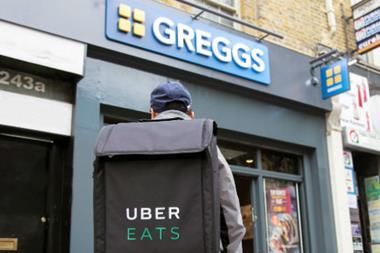Next month, the FSA will publish research into how the British public is using traffic light labels. But with the EU leaning towards a simpler system, how isolated is the UK on nutrition labelling, asks Nick Hughes
An effective tool for consumer information, or a flawed system that unfairly demonises foods? The Food Standard's Agency's traffic light labelling system has polarised opinion since the UK Government first threw its weight behind colour-coded labels in 2005.
Next month, the FSA is due to publish its first in-depth research into how consumers are using nutrition labelling. Only the most naïve of observers doubt the research will portray traffic lights in anything other than a positive light. As one industry source wryly comments: "With any survey, if you write the questions, you can get the responses you want."
But as the Consumer Information Act -an EU-wide mandate on nutrition labelling - rumbles through Brussels, any expected FSA victory looks increasingly to be a pyrrhic one, as traffic lights struggle to find supporters.
And the FSA research is far from the only flashpoint between the UK and the EU surrounding nutrition labelling in the coming months. Mandatory labelling, font size, country-of-origin labelling, national schemes and regulation on nutrition and health claims are all being contested to varying degrees in the corridors of power.
So, how divided are Westminster and Brussels on nutrition labelling? Just how much of a mess is labelling legislation in? And when is progress likely to be made?
The Consumer Information Act is currently awaiting its first reading in the European Parliament. Unfortunately, as ever with European legislation, there are complications. A delay in translating the approximate 1,000 amendments to the initial commission proposal means the chances of a first reading taking place before European elections in June are slim to none. The first reading would then be pushed over to the next Parliament, where a new set of MEPs would have to familiarise themselves with the proposal before a plenary vote could take place. The European Council, meanwhile, has numerous meetings scheduled for spring, but is far from reaching any kind of consensus, according to sources.
Nevertheless, there is enough evidence to suggest the European debate is leaning towards a more diluted approach to labelling, while pan-European research has cast doubts on how well traffic lights inform consumer decision making.
"The FSA research is interesting, but it's just one more piece of information," says Jane Holdsworth, the Food and Drink Federation's GDA campaign director. "There's been a lot of work into how consumers are responding to different types of labelling."
Indeed, a survey published by the European Food Information Council in October last year found almost three quarters of consumers misinterpreted traffic lights, believing a red light meant they should avoid eating the product.
With representatives from 27 Member States fighting their corner on nutrition labelling, the UK Government's voice is just one in a crowded room. And the early signs are that it is being drowned out.
One of the most influential voices in the debate, that of Consumer Information Act rapporteur Renate Sommer, has publicly declared opposition to traffic lights.
"In Germany, if people see a red light they immediately think 'stop' and will no longer buy the product," she told delegates at a recent FDF conference in Brussels.
Sommer has set out her stall to push for a more pragmatic approach to front-of-pack labelling. Remarking on the original commission proposal, which called for a "comprehensive nutrition declaration in the principal field of vision", Sommer says: "Cramming an excessive amount of nutrition information on the front of food packages would ultimately result in the information in question being ignored.
"Since current findings suggest the overwhelming majority of consumers are mainly interested in the energy content of foods, the mandatory indication of the energy content on the front of the package should be enough," she adds.
As well as softening the burden on lesser developed EU member states, a single calorie-icon approach would also dovetail nicely with recent moves by the foodservice industry to display energy information at the point of sale. "There's great value for consumers in having consistent food information," says Holdsworth.
A single-icon approach - potentially supported by back-of-pack GDAs - stops short of what is already accepted practice in the UK. As one industry source close to Brussels says: "You've got to remember how far ahead the UK is on labelling. Some countries are only just doing qualitative ingredients labelling."
Should Europe overlook traffic lights in its mandate, it would seriously weaken the FSA's hand in persuading the UK food industry to voluntarily adopt the system. To add to the FSA's apparent isolation, voluntary support of traffic lights has met with a muted response from the industry. McCain is the biggest manufacturer to have adopted traffic lights (its chips achieve green lights thanks to the 100g base of the FSA model), while among the big four, Sainsbury's uses colour-coded charts and Asda has its own hybrid scheme that combines GDA and traffic light information.
On the other side of the fence, major players including Tesco, Morrisons, Nestlé, Mars, Coca-Cola and PepsiCo have thrown their weight behind GDAs. And they are not alone. "By the end of the year, there will be around 20 of the largest European manufacturers using 100% GDAs on their products," says Mella Frewen, director general of the Confederation of the Food and Drink Industries of the EU.
So what chance is there of persuading these industry giants to adopt traffic lights before EU regulation is passed? The FSA's findings have to be viewed in the context of four factors, says Holdsworth: the evidence; what is going to happen in Europe; regulatory impact assessment; and cost benefits. "The company has to weigh the cost of changing the information against the benefit it's going to deliver," she says. "To change something and spend millions re-educating the consumer, then having to change it again doesn't make sense."
One regulatory affairs manager from a major multinational sums up the industry's predicament succinctly. "There's just no way you could change labels now before the regulation comes through."
The FSA's salvation could lie in a clause of the original proposal, which gives "considerable scope to adopt national labelling schemes" on top of any mandated information from Brussels. The proposal has come in for fierce criticism, however, for its potential to jeopardise free trade across the EU. "National schemes go against the single market," says Frewen. "When you've got rules to do one thing in one country and rules to do another thing in another country, then you've got confusion."
On this point, Frewen has a powerful ally in Sommer. "The proposal to grant member states considerable leeway to adopt their own rules seems completely incomprehensible. It would further fragment the internal market in the food sphere and render the proposal for a regulation under consideration here absurd."
The adoption of traffic lights throughout Europe looks unlikely, leaving the FSA's bargaining power with the UK food industry severely depleted. "It is too early to anticipate what the conclusions of our research will be - we, along with all stakeholders, are awaiting the outcome," says an FSA spokeswoman. "The agency will stand by the findings and will reflect on how the research fits with our existing advice on front-of-pack labelling."
But if Europe goes against traffic lights, national measures will be impossible, says the regulatory affairs manager.
"There might be a few traffic light labels hanging about for a few years around Europe, but hopefully here in the UK they will become obsolete."
An effective tool for consumer information, or a flawed system that unfairly demonises foods? The Food Standard's Agency's traffic light labelling system has polarised opinion since the UK Government first threw its weight behind colour-coded labels in 2005.
Next month, the FSA is due to publish its first in-depth research into how consumers are using nutrition labelling. Only the most naïve of observers doubt the research will portray traffic lights in anything other than a positive light. As one industry source wryly comments: "With any survey, if you write the questions, you can get the responses you want."
But as the Consumer Information Act -an EU-wide mandate on nutrition labelling - rumbles through Brussels, any expected FSA victory looks increasingly to be a pyrrhic one, as traffic lights struggle to find supporters.
And the FSA research is far from the only flashpoint between the UK and the EU surrounding nutrition labelling in the coming months. Mandatory labelling, font size, country-of-origin labelling, national schemes and regulation on nutrition and health claims are all being contested to varying degrees in the corridors of power.
So, how divided are Westminster and Brussels on nutrition labelling? Just how much of a mess is labelling legislation in? And when is progress likely to be made?
The Consumer Information Act is currently awaiting its first reading in the European Parliament. Unfortunately, as ever with European legislation, there are complications. A delay in translating the approximate 1,000 amendments to the initial commission proposal means the chances of a first reading taking place before European elections in June are slim to none. The first reading would then be pushed over to the next Parliament, where a new set of MEPs would have to familiarise themselves with the proposal before a plenary vote could take place. The European Council, meanwhile, has numerous meetings scheduled for spring, but is far from reaching any kind of consensus, according to sources.
Nevertheless, there is enough evidence to suggest the European debate is leaning towards a more diluted approach to labelling, while pan-European research has cast doubts on how well traffic lights inform consumer decision making.
"The FSA research is interesting, but it's just one more piece of information," says Jane Holdsworth, the Food and Drink Federation's GDA campaign director. "There's been a lot of work into how consumers are responding to different types of labelling."
Indeed, a survey published by the European Food Information Council in October last year found almost three quarters of consumers misinterpreted traffic lights, believing a red light meant they should avoid eating the product.
With representatives from 27 Member States fighting their corner on nutrition labelling, the UK Government's voice is just one in a crowded room. And the early signs are that it is being drowned out.
One of the most influential voices in the debate, that of Consumer Information Act rapporteur Renate Sommer, has publicly declared opposition to traffic lights.
"In Germany, if people see a red light they immediately think 'stop' and will no longer buy the product," she told delegates at a recent FDF conference in Brussels.
Sommer has set out her stall to push for a more pragmatic approach to front-of-pack labelling. Remarking on the original commission proposal, which called for a "comprehensive nutrition declaration in the principal field of vision", Sommer says: "Cramming an excessive amount of nutrition information on the front of food packages would ultimately result in the information in question being ignored.
"Since current findings suggest the overwhelming majority of consumers are mainly interested in the energy content of foods, the mandatory indication of the energy content on the front of the package should be enough," she adds.
As well as softening the burden on lesser developed EU member states, a single calorie-icon approach would also dovetail nicely with recent moves by the foodservice industry to display energy information at the point of sale. "There's great value for consumers in having consistent food information," says Holdsworth.
A single-icon approach - potentially supported by back-of-pack GDAs - stops short of what is already accepted practice in the UK. As one industry source close to Brussels says: "You've got to remember how far ahead the UK is on labelling. Some countries are only just doing qualitative ingredients labelling."
Should Europe overlook traffic lights in its mandate, it would seriously weaken the FSA's hand in persuading the UK food industry to voluntarily adopt the system. To add to the FSA's apparent isolation, voluntary support of traffic lights has met with a muted response from the industry. McCain is the biggest manufacturer to have adopted traffic lights (its chips achieve green lights thanks to the 100g base of the FSA model), while among the big four, Sainsbury's uses colour-coded charts and Asda has its own hybrid scheme that combines GDA and traffic light information.
On the other side of the fence, major players including Tesco, Morrisons, Nestlé, Mars, Coca-Cola and PepsiCo have thrown their weight behind GDAs. And they are not alone. "By the end of the year, there will be around 20 of the largest European manufacturers using 100% GDAs on their products," says Mella Frewen, director general of the Confederation of the Food and Drink Industries of the EU.
So what chance is there of persuading these industry giants to adopt traffic lights before EU regulation is passed? The FSA's findings have to be viewed in the context of four factors, says Holdsworth: the evidence; what is going to happen in Europe; regulatory impact assessment; and cost benefits. "The company has to weigh the cost of changing the information against the benefit it's going to deliver," she says. "To change something and spend millions re-educating the consumer, then having to change it again doesn't make sense."
One regulatory affairs manager from a major multinational sums up the industry's predicament succinctly. "There's just no way you could change labels now before the regulation comes through."
The FSA's salvation could lie in a clause of the original proposal, which gives "considerable scope to adopt national labelling schemes" on top of any mandated information from Brussels. The proposal has come in for fierce criticism, however, for its potential to jeopardise free trade across the EU. "National schemes go against the single market," says Frewen. "When you've got rules to do one thing in one country and rules to do another thing in another country, then you've got confusion."
On this point, Frewen has a powerful ally in Sommer. "The proposal to grant member states considerable leeway to adopt their own rules seems completely incomprehensible. It would further fragment the internal market in the food sphere and render the proposal for a regulation under consideration here absurd."
The adoption of traffic lights throughout Europe looks unlikely, leaving the FSA's bargaining power with the UK food industry severely depleted. "It is too early to anticipate what the conclusions of our research will be - we, along with all stakeholders, are awaiting the outcome," says an FSA spokeswoman. "The agency will stand by the findings and will reflect on how the research fits with our existing advice on front-of-pack labelling."
But if Europe goes against traffic lights, national measures will be impossible, says the regulatory affairs manager.
"There might be a few traffic light labels hanging about for a few years around Europe, but hopefully here in the UK they will become obsolete."
Health claims
In July, the European Food Safety Authority is expected to provide feedback on the nutritional health claims made by manufacturers. For manufacturers to win approval, any claims such as 'low fat', 'no added sugar' and 'high in fibre' will have to be clear, accurate and substantiated by scientific evidence. Based on the EFSA findings, the EC plans to establish an EU-wide list of permitted health claims by as early as January next year. And it's left manufacturers, especially those that produce long-life products, concerned. "At the moment there isn't a transitional period, so the very day the EU publishes its list, the manufacturers not included will be unable to use their nutrition claims," explains Helen McDermott, food labelling manager at the FDF. "Manufacturers still don't have an idea as to what will be on the approved list in little more than 10 months' time. We're campaigning for a 12-month transitional period." Manufacturers may yet earn more time - latest reports from Brussels suggest the EFSA has sent back more than half of the 4,000+ expected claims to the EC and member states for further clarification.
Mandatory labelling
The original commission proposal on labelling was broadly based on the GDA model. It called for labelling "in the principal field of vision" relating to energy, fat, nutrients, saturates, carbohydrates, salt and sugar per 100g or per portion. Rapporteur Renate Sommer has voiced concerns that too much front-of-pack information would confuse consumers. She favours the mandatory indication of energy content on front-of-pack , supported by a back-of-pack 'nutrition box'. She has also taken the commission to task for submitting the proposal before the results of piecemeal scientific research are available.
Font size
The commission's proposal that all information be presented in a minimum font size of 3mm has been widely criticised. Sommer describes it as "not workable", claiming it would result in bulkier packaging, more waste and possibly even larger portions. One industry source suggests that the council discussions on font size now centre on a 1.2mm minimum. There are calls for more focus on clarity. "There's a lot more to it than the size of the text," says Mella Frewen, director general of the CIAA. "It's also about contrast, whether it's shadowed, what font you use and spacing between letters."
National schemes
The most controversial of the proposals would give individual member states considerable scope to adopt national labelling rules, such as the FSA's traffic light system, in addition to the mandatory EU rules. If pushed through, it would give the UK Government the power to foist traffic lights on the industry on top of the mandatory EU labelling provisions. The CIAA has voiced its strong opposition to national schemes, which it claims would damage the single market. The FDF, meanwhile, says the concept of national schemes "goes against the very nature of harmonising EU regulation".
Country of origin
Product origin is a contentious issue and one that has recently been brought to the UK public's attention by Jamie Oliver's crusade for better labelling of British pork. The proposal states country of origin information should be provided where it would be misleading not to, but concerns have been raised over the practicality of implementation. The FDF opposes any legal requirement to list the origin of ingredients in manufactured foods, claiming it would place a huge cost on manufacturers, many of which have flexible sourcing strategies. Thus far, the debate has shown little movement.
In July, the European Food Safety Authority is expected to provide feedback on the nutritional health claims made by manufacturers. For manufacturers to win approval, any claims such as 'low fat', 'no added sugar' and 'high in fibre' will have to be clear, accurate and substantiated by scientific evidence. Based on the EFSA findings, the EC plans to establish an EU-wide list of permitted health claims by as early as January next year. And it's left manufacturers, especially those that produce long-life products, concerned. "At the moment there isn't a transitional period, so the very day the EU publishes its list, the manufacturers not included will be unable to use their nutrition claims," explains Helen McDermott, food labelling manager at the FDF. "Manufacturers still don't have an idea as to what will be on the approved list in little more than 10 months' time. We're campaigning for a 12-month transitional period." Manufacturers may yet earn more time - latest reports from Brussels suggest the EFSA has sent back more than half of the 4,000+ expected claims to the EC and member states for further clarification.
Mandatory labelling
The original commission proposal on labelling was broadly based on the GDA model. It called for labelling "in the principal field of vision" relating to energy, fat, nutrients, saturates, carbohydrates, salt and sugar per 100g or per portion. Rapporteur Renate Sommer has voiced concerns that too much front-of-pack information would confuse consumers. She favours the mandatory indication of energy content on front-of-pack , supported by a back-of-pack 'nutrition box'. She has also taken the commission to task for submitting the proposal before the results of piecemeal scientific research are available.
Font size
The commission's proposal that all information be presented in a minimum font size of 3mm has been widely criticised. Sommer describes it as "not workable", claiming it would result in bulkier packaging, more waste and possibly even larger portions. One industry source suggests that the council discussions on font size now centre on a 1.2mm minimum. There are calls for more focus on clarity. "There's a lot more to it than the size of the text," says Mella Frewen, director general of the CIAA. "It's also about contrast, whether it's shadowed, what font you use and spacing between letters."
National schemes
The most controversial of the proposals would give individual member states considerable scope to adopt national labelling rules, such as the FSA's traffic light system, in addition to the mandatory EU rules. If pushed through, it would give the UK Government the power to foist traffic lights on the industry on top of the mandatory EU labelling provisions. The CIAA has voiced its strong opposition to national schemes, which it claims would damage the single market. The FDF, meanwhile, says the concept of national schemes "goes against the very nature of harmonising EU regulation".
Country of origin
Product origin is a contentious issue and one that has recently been brought to the UK public's attention by Jamie Oliver's crusade for better labelling of British pork. The proposal states country of origin information should be provided where it would be misleading not to, but concerns have been raised over the practicality of implementation. The FDF opposes any legal requirement to list the origin of ingredients in manufactured foods, claiming it would place a huge cost on manufacturers, many of which have flexible sourcing strategies. Thus far, the debate has shown little movement.













No comments yet